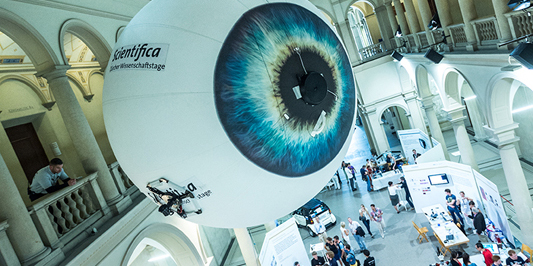Lights on for Scientifica 2015
At Scientifica 2015, everything revolves around the theme of light. This weekend’s event will feature 300 researchers from ETH and the University of Zurich presenting their work and explaining how they use light to observe and understand the world.
Astrophysicist Kevin Schawinski looks intently at his screen. He is examining data from a space telescope in order to try to learn more about the formation and effects of black holes. For Schawinski, light is the sole source of information for his research on the history of the universe since the Big Bang. But today his work will have to wait. The young ETH professor rushes off to a meeting with his research group, where the agenda centres not on technical discussion but rather on the astrophysicists’ appearance at external page Scientifica 2015. The researchers want to carry out another test of the infrared camera that visitors will be able to experiment with at Zurich Science Days.
At the same time, Andreas Wieser switches off the laser scanner in his laboratory. As the Chair of Geosensors and Engineering Geodesy, Wieser is working on new 3D measurement methods that can be used to monitor glaciers, dams, hillsides and tunnels, as well as much smaller objects. He concludes his experiment for today, as he wants to join his colleagues to view video footage that they will present at their Scientifica stand. The group has come up with something special for the occasion: visitors will be able to have their faces scanned and take home a 3D model of it on a USB stick.
Light wizardry and animation effects
ETH Vice President Detlef Günther takes a break between two meetings. He opens the window and looks out on to the Polyterrasse, where construction work for Scientifica is in full swing. This weekend, the large marquee will be filled with the sound of delighted children when Christoph Aegerter of the University of Zurich uses his colour and light magic to show how captivating physics can be. Science Slammers will vie for the audience’s favour and work to inspire enthusiasm for their research. And scientists from Disney Research will show the film Frozen and explain which reflections and lighting effects were created in their laboratory.
Günther closes the window again. He is looking forward to opening the universities’ doors alongside his colleagues from ETH and the University of Zurich. “We want to show visitors how our researchers work with light and explain to them why science is engaged in light, in all its forms,” he says. For Günther, Scientifica provides a unique opportunity to present research to the general public right where the action happens – and to engage in dialogue with the people attending the event.
Meanwhile, Schawinski is looking through the Scientifica programme. He has put a red mark next to Sunday afternoon’s panel discussion on open access, which will centre on whether scientific findings should be freely accessible to all. Wieser, on the other hand, will try to see as many exhibition stands as possible. But he isn’t making a plan, as he often finds the most interesting things in the last place he expects. And he’s hoping to experience the same good fortune again this year.
Win tickets to the opening event
ETH News is giving away 10 pairs of tickets to the Scientifica 2015 opening event to be held on Friday, 4 September from 5.30 pm to 7 pm in the marquee on the Polyterrasse. After a welcome address by ETH President Lino Guzzella and University of Zurich President Michael Hengartner, scientists from both universities will present current research projects and the Mayor of Zurich, Corine Mauch, will explain why ETH and the University of Zurich are two of the city’s most distinguished institutions.
To take part in the draw, send an email with the subject “Scientifica 2015” to news@hk.ethz.ch.
Robotics workshops for kids
These Scientifica workshops give 10- to 14-year-olds the chance to program a small robot – and there are still a few spots available: external page http://bit.ly/roboterworkshop

Comments
No comments yet